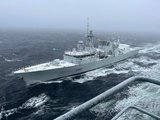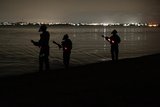Sonardyne upgrades Sentinel IDS
A new portable variant of Sonardyne’s Sentinel diver detection sonar has been installed at an undisclosed coastal facility in the Middle East, the company announced on 7 April.
Sentinel has been upgraded to enable a single sonar processor topside unit to command each in-water sonar head, halving the previous number needed.
Sentinel is designed to provide underwater surveillance to prevent unauthorised access to military and high security facilities from under the water. It can identify divers and unmanned underwater vehicles approaching ports, harbours, critical national infrastructure, offshore energy platforms and private yachts.
The system uses acoustic signature classification techniques to classify the type of threat detected. Targets are automatically separated from non-threats such as fauna, cetacean, fish and flotsam, ensuring a low false alarm rate and maximum response time for security teams.
Sentinel’s small, lightweight sonar head can be permanently deployed on the seabed, from a jetty or over the side of a patrol vessel and once configured, can be left to run autonomously. It can be used as a standalone security measure or integrated with CCTV, radar and other sensors to enhance the situational awareness picture for large waterside facilities.
The new upgrades will allow users who need a rapidly deployable maritime security capability to protect waterside facilities and vessels against the threat of attack.
Nick Swift, business manager for maritime security, Sonardyne, said: ‘The introduction of a new, more powerful sonar processor for Sentinel demonstrates our commitment to ensuring that, as the threat landscape changes, our underwater technology evolves to keep pace with end-users’ requirements. The reduced footprint of the single head system now makes Sentinel IDS even more suitable for both rapid deployment and permanent installations.’
More from Naval Warfare
-
![US Navy to conduct an experimentation campaign with emerging tech in 2026 and 2027]()
US Navy to conduct an experimentation campaign with emerging tech in 2026 and 2027
The Technology Operational Experimentation Events will inform future requirements as the US Navy looks for innovative solutions across three key operational domains.
-
![US Navy to acquire micro-uncrewed underwater vehicles for ISR and coastal data collection]()
US Navy to acquire micro-uncrewed underwater vehicles for ISR and coastal data collection
The Naval Supply Systems Command is seeking authorised resellers of JaiaBot uncrewed underwater vehicles and multivehicle pods. The platforms will support undergraduate education at the US Naval Academy.
-
![NATO tests use of “undetectable, jam-proof” laser communication in maritime scenarios]()
NATO tests use of “undetectable, jam-proof” laser communication in maritime scenarios
As part of its effort to better prepare its capabilities for operations in contested and congested scenarios, NATO evaluated a Lithuanian ship-to-ship terminal designed to not be susceptible to enemy interference.
-
![US Navy advances with the Harpoon Service Life Extension Programme]()
US Navy advances with the Harpoon Service Life Extension Programme
The US Navy plans to improve Harpoon’s anti-ship and land attack capabilities by equipping the missiles with sensors and technologies required for succeeding in future battlespace.






















